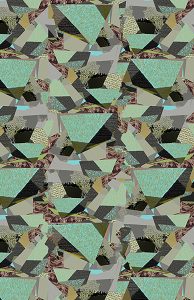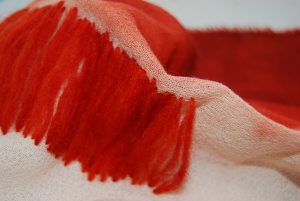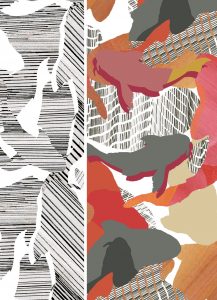Textile Design
I came away from the textile design graduate exhibition having picked up a substantial selection of business cards. In the one I’m holding, I can see repeating motifs – a distant sun emerging from an earthly globe, its horizontal rays transforming a dark cloud, a shadowy mountain. I’m holding Kirsten McLoskey’s card upside down, her designs are actually based on the architectures of bridges, and her collection is designed for public transport interiors. Her work is amongst the most understated in the exhibition, but it certainly fulfils her aims of occupying both the eye and mind. Several other graduates have also focused on stress relief and peace as a positive force. Abbi McCaffrey has created designs based on mandala shapes and feathery trees, derived from dynamic interactions of Quink, watercolour and bleach. So too, Sabah Sharif’s hand screen-printed cotton and silks are designed with serenity and tranquillity in mind. Her inspiration is based on her assertion that her religion, Islam, is “all about peace”. Her depictions of the movement of light and water are reflective and mesmerising.
The language of textile is one that speaks to the senses – visual of course and, just as importantly, touch – and I even saw a few visitors giving in to the urge to smell fabrics that have been dyed with madder root, beetroot, rhubarb, juniper berries. These exquisite drips and calligraphic marks result from the experimentation of Robyn Nisbet. She showcases her fabrics below shelves of glass jars and test tubes of berries and pigments, instantly exciting the childhood/chemistry/alchemy receptor. Her environmental justice agenda, that of rediscovering natural alternatives to caustic dyes, is reflected in her title Paradigm Shift. The sheer pleasure of being part of the Scottish countryside, of traversing fields and paths, is reflected in the moods and weights of Sophie Popham’s machine knitted fabrics. The effect of her collection, Cabin Fever, is shown in the economy of, in one example, knitting together soft grey wool with yellow cotton thread – conjuring the inevitability of filaments of stamens of blossom after that “Beast from the East” of a winter.
The quality of the making is often stunning – Alex Nicol has produced “gender-more” digitally printed textiles, allowing the wearer to celebrate their masculine and feminine sides in balance, and echoing this idea in an interplay of positive and negative space. Her Japanese-inspired work has been granted an award for “innovation in style, cut and structure” by the Tailor’s Trade of Dundee. Beautifully made, also, are the reconstructed fabric collages that Molly Jamshidian has reclaimed from what must have been a chaotic pile of old denim cotton and linen, now bleached, stitched, digitally printed in parts with geometric designs derived from Islamic art. She has recaptured that poetic unity perfectly. She has acknowledged both “calm and calamity”.
Textiles – in their making and wearing – can connect us with nature. What we choose to wear can both ground us and liberate us. This exhibition is a joyful celebration of self-confidence and self-expression. To adapt a phrase with which Elle Roche characterises the water of Arbroath docks which gave rise to her designs – the interplay of “bubble and grit” is evident in all of the work of these sparkling new graduates. There is plenty of evidence of the elements of earth, water and air as inspiration. The fire is perhaps present in the energy of re-emergence of a renewed self, despite, and after, cultural restrictions. I wonder, hasn’t textile art always had that function? Most importantly, they have each been consumed in the subversive fire of making.




I loved the textiles too, Dawn. Amazing work. I wanted to steal it all. Well done everyone.